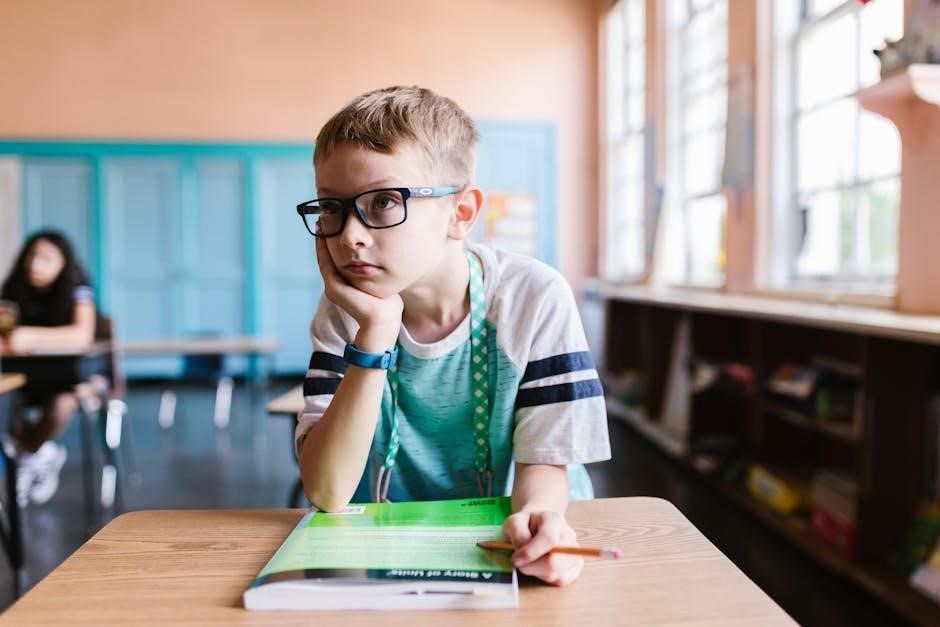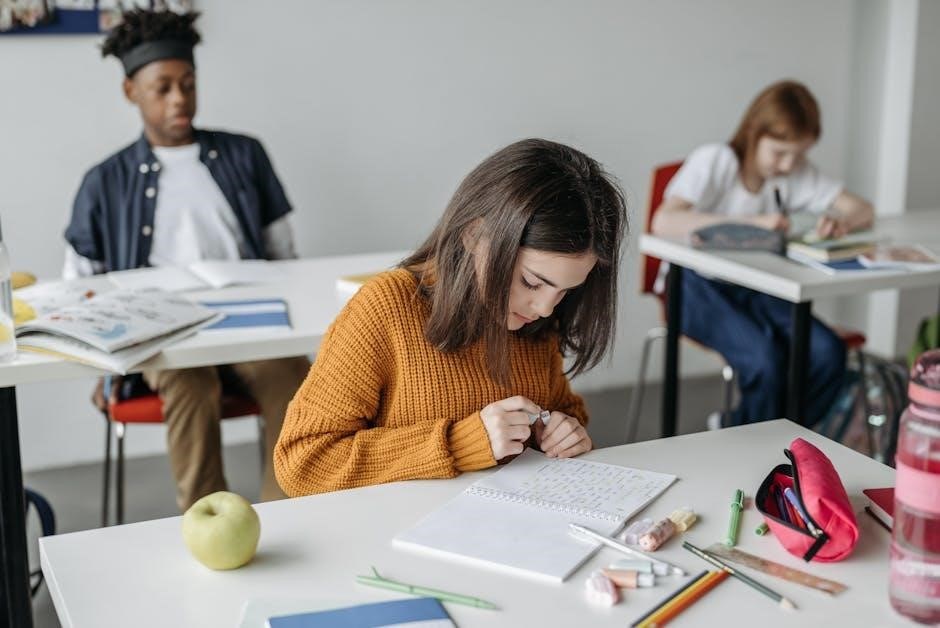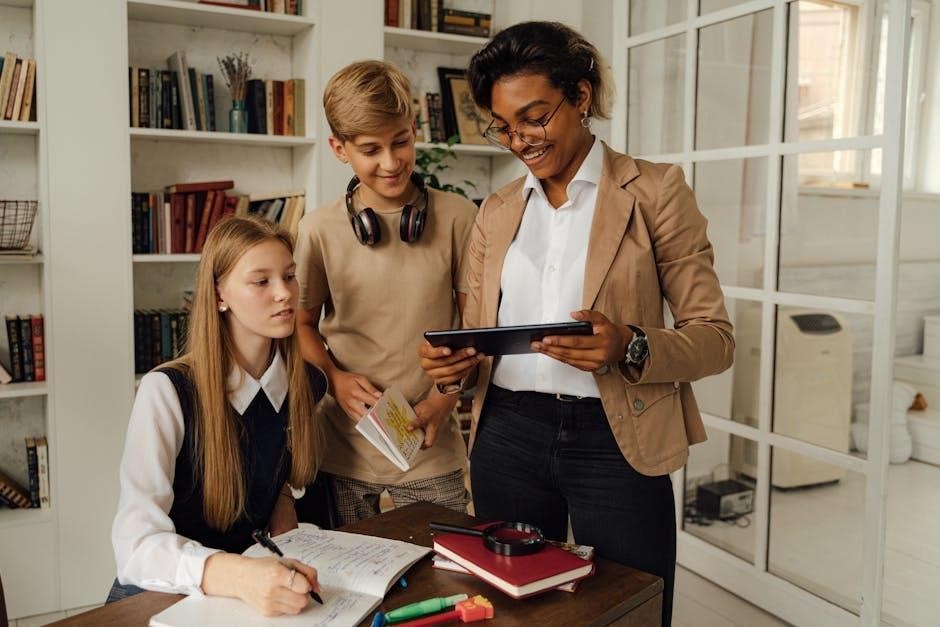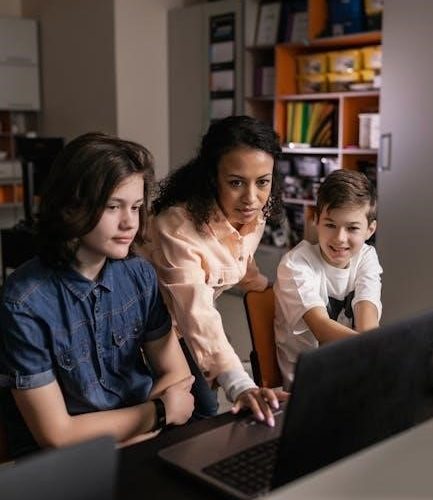Inclusive classroom strategies are essential for effective differentiated instruction‚ promoting equity and engagement for all learners. They create an equitable environment where educators can meet diverse student needs.
Defining Inclusive Education
Inclusive education is an educational approach that values diversity and promotes the participation of all students‚ regardless of their background‚ abilities‚ or needs. It emphasizes creating learning environments where every student feels valued‚ supported‚ and empowered to succeed. Inclusive education focuses on addressing barriers to learning and ensuring equitable access to opportunities for all learners. By fostering a sense of belonging and respecting diverse perspectives‚ inclusive education lays the foundation for differentiated instruction and equitable outcomes.
The Importance of Differentiated Instruction
Differentiated instruction is crucial for meeting the diverse needs of students in inclusive classrooms. It involves tailoring teaching methods‚ materials‚ and assessments to cater to varying learning styles‚ abilities‚ and interests. By recognizing that each student learns uniquely‚ educators can create engaging and challenging experiences that promote academic success. Differentiated instruction fosters equity‚ ensuring all students‚ regardless of their background or abilities‚ have opportunities to thrive. It aligns with inclusive education by providing flexible strategies that support individualized learning and help bridge gaps in student performance.
Creating an Equitable Learning Environment
Creating an equitable learning environment involves fostering a culture of respect‚ inclusivity‚ and belonging. Educators can achieve this by using culturally responsive practices‚ incorporating diverse materials‚ and ensuring accessibility for all students. Strategies like movement‚ interaction‚ and varied teaching methods cater to different learning preferences. By addressing socio-emotional needs and promoting positive behaviors‚ teachers can create a safe space where every student feels valued. Equitable environments also involve flexible grouping and technology integration‚ ensuring all learners have equal opportunities to succeed‚ regardless of their background or abilities.

Foundations of Inclusive Classrooms
Inclusive classrooms are built on principles like Universal Design for Learning and culturally responsive teaching‚ ensuring all students access learning. These strategies remove barriers and promote equity for diverse learners.
Universal Design for Learning (UDL)
Universal Design for Learning (UDL) provides a framework for inclusive education by offering multiple means of engagement‚ representation‚ and action & expression. This approach ensures learning is accessible to all students‚ regardless of their abilities or backgrounds. By incorporating flexible learning environments and materials‚ UDL minimizes barriers and maximizes opportunities for every learner. It emphasizes providing choices and scaffolding to meet diverse needs‚ fostering engagement and understanding. UDL is a cornerstone of inclusive classrooms‚ promoting equity and enabling all students to achieve their full potential.
Culturally Responsive Teaching
Culturally responsive teaching is a vital strategy for creating inclusive classrooms‚ recognizing and valuing students’ diverse backgrounds and experiences. It involves incorporating diverse perspectives into lessons‚ using culturally relevant materials‚ and fostering an environment where all students feel respected and valued. This approach encourages student engagement and academic success by connecting learning to their lives. Teachers who practice culturally responsive teaching build strong relationships and create a sense of belonging‚ ensuring that every student’s identity is acknowledged and supported. This fosters equity and enhances learning outcomes for all.
Understanding Student Diversity
Understanding student diversity is critical for inclusive classrooms‚ as it recognizes the unique cultural‚ social‚ emotional‚ and academic differences among learners. Teachers must acknowledge that students bring varied experiences‚ backgrounds‚ and abilities to the classroom. This understanding enables educators to tailor instruction to meet individual needs‚ fostering an inclusive environment where every student feels valued. Recognizing diversity also helps address barriers that may hinder learning‚ ensuring equitable opportunities for all. By embracing student diversity‚ teachers create a supportive space where differences are celebrated‚ and all learners can thrive academically and socially.
Strategies for Differentiated Instruction
Strategies include learning centers‚ technology integration‚ and flexible grouping‚ ensuring tailored instruction to meet diverse student needs and promote engagement in inclusive classrooms effectively.
Learning Centers and Stations
Learning centers and stations are interactive spaces that promote engagement and differentiation. They allow students to work independently or in groups‚ exploring topics at their own pace. By organizing thematic stations‚ educators cater to diverse learning styles and interests. These centers often incorporate hands-on activities‚ technology‚ and collaborative tasks‚ fostering deeper understanding. They also encourage movement and interaction‚ which can motivate learners. Key features include clear instructions‚ varied resources‚ and opportunities for reflection. This approach ensures all students‚ regardless of ability‚ can access meaningful learning experiences‚ making it a powerful tool in inclusive classrooms.
Technology Integration
Technology integration is a powerful strategy for differentiated instruction‚ offering personalized learning experiences. Adaptive software‚ multimedia resources‚ and interactive tools cater to diverse learning styles and abilities. Educators can use technology to provide scaffolded support‚ real-time feedback‚ and access to varied instructional materials. Interactive simulations and virtual labs enhance engagement‚ while online collaboration tools foster peer learning. Technology also facilitates Universal Design for Learning (UDL) principles‚ ensuring all students can access content in ways that suit their needs. This approach bridges gaps and promotes equity‚ making learning more accessible and effective for every student.
Flexible Grouping
Flexible grouping is a dynamic strategy that allows teachers to meet diverse student needs by grouping learners based on abilities‚ interests‚ or learning goals. This approach enables differentiated instruction‚ as students can work in small groups‚ pairs‚ or individually to complete tasks tailored to their level. Teachers can regroup students frequently based on formative assessments‚ ensuring each learner is appropriately challenged. Flexible grouping fosters collaboration‚ engagement‚ and personalized learning‚ while also promoting inclusivity by providing varied opportunities for all students to succeed and grow.

Assessment and Feedback in Inclusive Classrooms
Assessment and feedback are crucial for understanding student progress and guiding instruction. Inclusive classrooms use formative and summative assessments to ensure all learners receive constructive‚ timely feedback.
Formative Assessments
Formative assessments are essential for monitoring student progress and providing timely feedback. These ongoing evaluations help teachers identify learning gaps and adjust instruction to meet diverse needs. By using strategies like exit tickets‚ quizzes‚ and class discussions‚ educators can gauge understanding in real-time. This approach supports differentiated instruction by allowing for targeted interventions and ensuring all students‚ including those with special needs‚ receive appropriate support. Regular formative assessments also foster inclusivity by enabling teachers to modify lessons and engage students in meaningful ways‚ promoting equity and active participation in the classroom.
Summative Assessments
Summative assessments evaluate student learning at the end of a lesson‚ unit‚ or term‚ providing a comprehensive understanding of achievement. They help teachers determine if learning objectives have been met and identify areas for improvement. In inclusive classrooms‚ summative assessments should be designed to accommodate diverse needs‚ ensuring accessibility for all learners. This may include offering multiple formats‚ such as written‚ oral‚ or project-based assessments. By aligning assessments with differentiated instruction‚ educators can measure progress equitably while promoting academic integrity and transparency in grading practices.
Using Feedback to Guide Instruction
Using feedback to guide instruction is a powerful tool in inclusive classrooms‚ fostering growth and understanding for all learners. Regular‚ specific‚ and actionable feedback helps students track their progress and identify areas for improvement. Teachers can gather feedback through formative assessments‚ peer discussions‚ and self-reflection activities‚ ensuring it is equitable and accessible. By incorporating student voice‚ educators can tailor instruction to meet diverse needs‚ promoting engagement and academic success. Feedback also allows teachers to adjust strategies‚ creating a dynamic and responsive learning environment that values every student’s contributions and supports their unique learning journey.
Engaging Students in Inclusive Classrooms
Engaging students in inclusive classrooms involves strategies that foster active participation‚ curiosity‚ and meaningful learning experiences. By integrating diverse perspectives and interests‚ educators create environments where all students feel valued and motivated to succeed.
Project-Based Learning
Project-Based Learning (PBL) is a dynamic strategy that engages students in real-world‚ meaningful tasks‚ fostering critical thinking and collaboration. By allowing students to explore topics of interest‚ PBL caters to diverse learning styles and abilities‚ ensuring inclusivity. Teachers can differentiate instruction by providing varied resources‚ scaffolding‚ and assessment methods. PBL encourages creativity‚ problem-solving‚ and communication skills‚ preparing students for future challenges. It also promotes equity by giving all learners a voice and opportunities to shine‚ making it a powerful tool for inclusive classrooms.
- Promotes deeper understanding through hands-on experiences.
- Encourages collaboration and peer support.
- Meets diverse learning needs effectively.
Inquiry-Based Learning
Inquiry-Based Learning (IBL) is a student-centered approach that encourages exploration and discovery through open-ended questions and investigations. This method fosters critical thinking‚ curiosity‚ and creativity‚ engaging students in meaningful learning experiences. By allowing learners to take ownership of their inquiries‚ teachers can differentiate instruction to meet diverse needs. IBL promotes inclusivity by valuing diverse perspectives and allowing students to explore topics relevant to their lives‚ making it an effective strategy for inclusive classrooms.
- Encourages critical thinking and problem-solving.
- Supports diverse learning styles and interests.
- Fosters collaboration and deeper understanding.
Student-Led Discussions
Student-led discussions empower learners to take ownership of their education by facilitating conversations and guiding their peers. This strategy fosters active participation‚ critical thinking‚ and collaboration. By encouraging students to articulate their thoughts and listen to diverse perspectives‚ educators create an inclusive environment where all voices are valued. Student-led discussions also help teachers understand individual learning needs‚ enabling effective differentiation and promoting equity in the classroom.
- Encourages active participation and engagement.
- Develops communication and leadership skills.
- Supports diverse perspectives and inclusive learning.
Behavior Management in Inclusive Classrooms
Behavior management in inclusive classrooms focuses on creating a respectful environment through PBIS and restorative practices‚ fostering positive interactions and supporting diverse student needs effectively.
Positive Behavioral Interventions and Supports (PBIS)
Positive Behavioral Interventions and Supports (PBIS) is a proactive approach to fostering a positive classroom environment. It focuses on preventing problem behaviors by teaching and reinforcing positive alternatives. PBIS emphasizes data-driven decision-making to identify and address behavioral challenges early. Strategies include clear expectations‚ positive reinforcement‚ and restorative practices. This framework supports all students‚ including those with diverse needs‚ by creating a consistent and equitable system. By promoting social-emotional learning‚ PBIS enhances academic engagement and reduces disruptions‚ ensuring a respectful and inclusive classroom culture for all learners.
Restorative Practices
Restorative practices focus on building and repairing relationships within the classroom community. They emphasize empathy‚ accountability‚ and understanding through structured conversations and activities. Strategies like restorative circles and reflective discussions help students resolve conflicts and take responsibility for their actions. These practices foster a safe and inclusive environment‚ encouraging social-emotional growth and reducing disciplinary issues. By addressing the root causes of behavior‚ restorative practices promote equity and create opportunities for all students to thrive academically and socially. They are a powerful tool for creating a respectful and connected classroom culture.
Creating a Safe and Respectful Environment
Creating a safe and respectful classroom environment is crucial for fostering inclusivity and promoting student well-being. This involves establishing clear expectations for behavior‚ encouraging empathy‚ and addressing biases. Teachers can use community-building activities‚ such as class discussions and team-building exercises‚ to cultivate a sense of belonging. By integrating diverse perspectives and promoting social-emotional learning‚ educators can create a space where all students feel valued and supported. This foundation of respect and safety enables students to thrive academically and socially‚ ensuring equitable opportunities for all learners.
Supporting Diverse Learners
Supporting diverse learners involves creating an inclusive environment that values individual differences. Using strategies like Universal Design for Learning and culturally responsive practices ensures all students can thrive. These approaches empower teachers to address varied learning needs effectively;
Strategies for Students with Special Needs
Strategies for students with special needs focus on creating personalized learning plans tailored to individual requirements. Universal Design for Learning (UDL) and Universal Design for Instruction (UDI) frameworks help design accessible lessons. Assistive technologies‚ such as text-to-speech tools‚ enable students to engage with content independently. Positive Behavioral Interventions and Supports (PBIS) foster a supportive environment‚ while multisensory approaches cater to diverse learning styles. These strategies ensure that students with special needs can access the curriculum effectively‚ fostering academic and social growth in inclusive settings.
Supporting English Language Learners
Supporting English Language Learners involves scaffolding instruction to build language proficiency alongside academic skills. Visual aids‚ bilingual resources‚ and multicultural materials help bridge language gaps. Encouraging peer interactions and small-group work fosters collaborative learning. Providing sentence stems and graphic organizers supports language development. Teachers can also use technology‚ such as translation tools‚ to enhance understanding. Creating a safe‚ inclusive environment where students feel comfortable practicing language skills is crucial. These strategies ensure ELLs can access the curriculum while developing their English proficiency in a supportive and equitable classroom setting.
Addressing Socio-Emotional Needs
Addressing socio-emotional needs is vital for creating a supportive learning environment. Teachers can foster emotional well-being by incorporating social-emotional learning (SEL) activities‚ such as mindfulness exercises and role-playing. Creating a safe space for open discussions and using restorative practices helps students manage conflicts and build empathy. Providing opportunities for reflection‚ like journaling or class circles‚ encourages self-awareness and self-regulation. Additionally‚ offering individualized support and collaborating with counselors ensures students receive tailored guidance. These strategies promote emotional resilience‚ helping students navigate challenges and thrive academically and socially in an inclusive classroom setting.

Collaboration and Communication
Collaboration and communication are key to inclusive classrooms. Teachers‚ parents‚ and peers must work together‚ ensuring clear communication to support differentiated instruction and foster a shared understanding of student needs.
Parent-Teacher Collaboration
Parent-teacher collaboration is vital for inclusive classrooms‚ fostering a partnership that supports differentiated instruction. Regular communication ensures alignment of goals and strategies‚ benefiting student outcomes. Parents provide insights into their child’s strengths and needs‚ while teachers share classroom practices. This collaboration creates a cohesive learning environment‚ enhancing equity and engagement. By involving parents in decision-making‚ educators ensure that all voices are heard‚ promoting a culture of shared responsibility. This partnership not only strengthens academic support but also builds trust‚ fostering a welcoming and inclusive space for all learners‚ regardless of their background or abilities.
Peer Support and Mentorship
Peer support and mentorship are powerful tools in inclusive classrooms‚ fostering collaboration and mutual learning. Students can act as buddies or study partners‚ providing academic and emotional support. Structured programs‚ such as peer mentoring‚ encourage leadership and confidence-building while addressing diverse needs. This approach strengthens social connections and reduces feelings of isolation. By involving students in each other’s learning journeys‚ educators create an inclusive environment where everyone feels valued and supported‚ enhancing engagement and overall academic success for all learners. Peer support also bridges gaps between learners‚ promoting equity and shared growth.
Interdisciplinary Collaboration
Interdisciplinary collaboration involves teachers from different subjects working together to create cohesive‚ integrated lesson plans. This approach enriches learning by connecting diverse curriculum areas‚ making instruction more relevant and engaging. By pooling expertise‚ educators can design activities that cater to varied learning styles and needs. Collaboration fosters a sense of community and shared goals among teachers‚ ensuring a more comprehensive education. It also encourages creative problem-solving and innovation‚ benefiting both students and educators. This strategy enhances differentiated instruction by providing multiple pathways for learning and fostering a culture of shared responsibility for student success.

Professional Development for Inclusive Teaching
Professional development for inclusive teaching involves workshops‚ coaching‚ and reflective practices‚ equipping educators with strategies to support diverse learners and implement differentiated instruction effectively.
Workshops and Training
Workshops and training programs are essential for developing inclusive teaching skills‚ offering educators practical strategies to implement differentiated instruction. These sessions focus on understanding diverse learner needs‚ applying Universal Design for Learning (UDL)‚ and managing inclusive classrooms effectively. Participants engage in hands-on activities‚ case studies‚ and expert-led discussions to enhance their ability to create equitable learning environments. Workshops also address technology integration and cultural responsiveness‚ providing teachers with tools to support all students. Regular training ensures educators stay updated on best practices‚ fostering a culture of inclusion and continuous improvement in their teaching approaches.
Coaching and Mentoring
Coaching and mentoring are vital for fostering inclusive teaching practices‚ providing educators with personalized guidance and support. These one-on-one interactions help teachers refine their skills in differentiated instruction‚ ensuring they meet the diverse needs of all learners. Coaches and mentors offer tailored strategies‚ feedback‚ and encouragement‚ enabling educators to create equitable learning environments. Regular mentoring sessions also promote reflective practice‚ helping teachers adapt to challenges and continuously improve their inclusive classroom strategies. This collaborative approach ensures consistency and effectiveness in implementing inclusive education principles‚ ultimately benefiting both teachers and students.
Reflective Practice
Reflective practice involves educators examining their teaching methods to enhance classroom inclusivity and effectiveness. By regularly reflecting on their strategies‚ teachers identify strengths and areas needing improvement‚ fostering a growth mindset. This process helps in tailoring instruction to meet diverse student needs‚ ensuring equitable learning opportunities. Reflective practice also encourages educators to adapt innovative approaches‚ ultimately improving student outcomes and upholding the principles of inclusive education.
Measuring the Effectiveness of Inclusive Strategies
Measuring effectiveness involves regular assessments‚ classroom observations‚ and student feedback to ensure inclusive strategies support diverse learners and improve instruction.
Student Outcomes and Progress
Measuring student outcomes and progress is crucial to evaluate the effectiveness of inclusive strategies. By using Universal Design for Learning (UDL) frameworks‚ educators can identify barriers and adapt instruction to meet diverse needs. Regular formative assessments and summative evaluations provide insights into student learning‚ ensuring tailored support. Feedback from students helps refine teaching methods‚ fostering an equitable environment. Tracking progress over time allows teachers to adjust strategies‚ ensuring all learners achieve their potential. This data-driven approach supports differentiated instruction‚ promoting academic and social growth for every student.
Classroom Observations
Classroom observations are a powerful tool for assessing the effectiveness of inclusive strategies. By systematically observing student interactions‚ engagement‚ and learning behaviors‚ educators can identify strengths and areas for improvement. Observations help teachers evaluate how well differentiated instruction meets individual needs. Tools like observation checklists or reflective notes guide the process‚ ensuring a focus on equity and inclusivity. Regular observations also foster reflective practice‚ allowing teachers to refine their methods and create a more supportive learning environment. This ongoing monitoring ensures all students receive the necessary accommodations to thrive academically and socially.
Teacher and Student Feedback
Teacher and student feedback is crucial for refining inclusive classroom strategies. Midterm evaluations and observation protocols provide insights into the classroom climate and instructional effectiveness. Students’ perceptions reveal how well inclusive practices are implemented. Teachers can use this feedback to adjust their methods‚ ensuring all learners feel valued and supported. Regular feedback loops foster a growth-oriented environment‚ helping educators identify and address equity gaps. By actively seeking and incorporating feedback‚ teachers can enhance engagement‚ improve outcomes‚ and create a more inclusive and responsive learning space for all students.
Challenges and Solutions in Inclusive Classrooms
Inclusive classrooms face challenges like resource constraints‚ managing diverse needs‚ and overcoming bias. Creative solutions‚ such as flexible grouping and culturally responsive practices‚ help address these barriers effectively.
Addressing Resource Constraints
Resource constraints can hinder the implementation of inclusive strategies‚ but creative solutions exist. Educators can utilize free or low-cost educational tools‚ repurpose materials‚ and integrate technology to enhance accessibility. Collaborating with colleagues and involving the community can also provide additional resources. Professional development focused on resource management and Universal Design for Learning (UDL) frameworks can help maximize available resources. By prioritizing flexibility and innovation‚ teachers can overcome financial and material limitations to create an inclusive learning environment that supports all students effectively.
Managing Diverse Needs
Managing diverse needs in inclusive classrooms requires tailored strategies to support all learners. Teachers can use differentiated instruction‚ incorporating Universal Design for Learning (UDL) principles to provide multiple means of engagement‚ representation‚ and expression. Leveraging technology and flexible grouping allows for personalized learning experiences. Additionally‚ fostering collaboration with special education specialists and involving students in goal-setting empowers them to take ownership of their learning. By addressing individual differences and leveraging available tools‚ educators can create a balanced and supportive environment that caters to the unique requirements of each student‚ ensuring equitable opportunities for success.
Overcoming Bias and Stereotypes
Overcoming bias and stereotypes in inclusive classrooms involves fostering a culture of empathy and respect. Teachers can promote diversity by incorporating diverse perspectives in materials and discussions. Engaging students in culturally responsive practices helps break down stereotypes. Encouraging open dialogue and reflective practices allows students to explore and challenge their own biases. Professional development for educators on unconscious bias and inclusive pedagogies further supports equitable teaching. By addressing these issues proactively‚ educators can create a classroom environment where all students feel valued and represented‚ fostering a sense of belonging and inclusivity.

Future Trends in Inclusive Education
Future trends emphasize personalized learning‚ AI-driven adaptive technologies‚ and global collaboration to enhance accessibility and equity in education‚ ensuring inclusive opportunities for all learners worldwide.
Personalized Learning
Personalized learning tailors instruction to meet individual student needs‚ fostering engagement and achievement. By leveraging technology and Universal Design for Learning (UDL)‚ educators create flexible learning pathways that cater to diverse learning styles and abilities. This approach ensures that all students‚ including those with special needs or language barriers‚ have access to meaningful learning experiences. Personalized learning promotes equity by addressing varying skill levels and interests‚ enabling teachers to differentiate instruction effectively. It also encourages student autonomy‚ allowing learners to take ownership of their educational journey‚ thus enhancing overall academic outcomes and inclusivity in the classroom.
AI and Adaptive Technologies
AI and adaptive technologies are revolutionizing inclusive classrooms by providing personalized learning experiences. These tools use data to tailor instruction to individual needs‚ ensuring all students‚ including those with disabilities or language barriers‚ can engage meaningfully. Adaptive software adjusts content difficulty based on student performance‚ while AI-driven platforms offer real-time feedback and support. Such technologies enhance accessibility‚ enabling students to learn at their own pace. They also help teachers identify gaps and differentiate instruction effectively‚ fostering an equitable and inclusive learning environment that maximizes student potential and promotes academic success for all learners.
Global Perspectives on Inclusion
Global perspectives on inclusion highlight the importance of cultural sensitivity and international collaboration in shaping inclusive classrooms. Educators worldwide share strategies to address diverse student needs‚ emphasizing equity and accessibility. Inclusive education models from various countries demonstrate how cultural contexts influence teaching practices. For example‚ some regions focus on community involvement‚ while others prioritize technology integration. These global insights provide a broader understanding of inclusion‚ encouraging educators to adapt strategies that resonate with their local contexts while fostering a shared commitment to equitable education for all learners.
